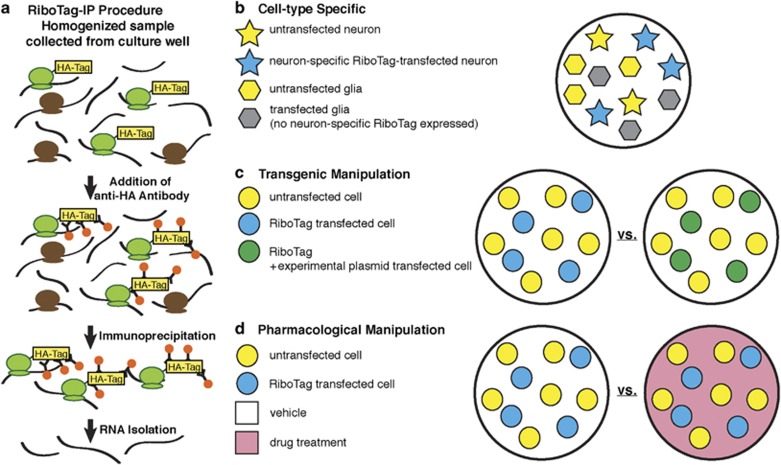Measuring RNA from a defined subset of cells derived from a complex tissue is an important challenge that has confounded the field. Two recently developed tools have simplified this issue. The RiboTag and BacTRAP (Translating Ribosome Affinity Purification) methods allow for immunoprecipitation of ribosome-associated RNA from specific cells within complex tissues by expressing tagged ribosomal protein in desired cell types (GFP-tagged RPL10 for TRAP and hemagglutinin-tagged RPL22 for RiboTag) (Doyle et al, 2008; Heiman et al, 2008; Sanz et al, 2009). More specifically, these methods allow analysis of the ‘translatome'—ribosome-associated mRNA—which may be particularly sensitive to event-dependent regulation of protein translation. For example, RiboTag-expressing transgenic mice were recently used to compare differential gene expression responses to cocaine in striatal neurons expressing D1 and D2 dopamine receptors (Chandra et al, 2015).
Because RiboTag and BacTRAP allow the measurement of ribosome-associated mRNA, it is not a direct reflection of the pool of total RNA but can provide intriguing insights into regulatory shifts in protein synthesis in response to a stimulus. Conditional expression using either Cre-dependent viral vectors or transgenic breeding strategies allows highly specific expression of RiboTag in desired cells, and the RNA enriched from the immunopurification can be efficiently harvested and interrogated using RT-PCR, microarrays, or RNA-seq. For example, we have used dual-virus transduction approaches to analyze the molecular phenotype of distinct output pathways in lateral habenula and have utilized transgenic mice that express RiboTag in Pet1-positive neurons to investigate how stress alters the translatome in serotonin neurons.
Recently, our laboratory demonstrated a novel application of RiboTag for in vitro cell culture studies (Lesiak et al, 2015) (Figure 1). Primary neuronal cultures consisting of both neurons and glia are a common model system for investigating gene regulation and cell physiology, but low transfection efficiency and the presence of mixed cell types complicate detection of experimental manipulations on RNA dynamics. By co-transfecting RiboTag plasmid with experimental plasmids such as DREADD receptors or shRNA-knockdown constructs, we were able to measure changes in gene translation specifically in transfected neurons. These experimental plasmid manipulations can utilize knockdown or overexpression of various proteins and circumvent the problem of RNA contamination from untransfected neurons or glia. For example, co-transfection of RiboTag with wild-type or mutated receptors into cells from a knockout background allows efficient comparison of the effects of a variety of receptor mutants and pharmacological treatments in primary neurons even after sparse transfection. Using cell type-specific promoters to drive RiboTag expression can provide further refinement in translation analysis despite culturing these cells within a more diverse population of primary neurons and glia (Figure 1c and d).
Figure 1.
Examples of in vitro RiboTag applications for primary cultures. (a) Representation of translating RNA isolation using RiboTag immunoprecipitation. (b) Cell-type specific: cultures containing mixed cellular populations are transfected with RiboTag plasmids that restrict RiboTag expression to specific cells using cell type-specific promoters. RiboTag-isolated RNA from specific cell types can then be quantified. (c) Transgenic manipulation: cell cultures are transfected with RiboTag alone or co-transfected with transgenes that enhance or inhibit expression of specific proteins. RiboTag-isolated RNA can measure the effect of transgenic manipulations on RNA translation. (d) Pharmacological manipulation: cultures are transfected with RiboTag and then treated with drug or vehicle. Drug-induced changes in RNA translation can then be measured using RiboTag-isolated RNA from vehicle and drug-treated samples.
Whether in vivo or in vitro, the RiboTag strategy provides a new ability to identify altered patterns of RNA translation in specific cell types within a heterogenous background. Although many techniques to measure cell-specific transcription like DROPseq and FACS require extensive tissue processing and specialized equipment, the RiboTag method is highly flexible, requires minimal specialized equipment, and can be easily established in almost any laboratory. Application of this novel and widely useful technique has only begun to be realized and will surely lead to novel insights into the complex regulation of gene expression.
FUNDING AND DISCLOSURE
John F Neumaier was supported by MH106532, MH106428, and DA035577 and a gift from the estate of Daniel Davis. Adam J Lesiak was supported by the training grant DA00007278.
References
- Chandra R, Francis TC, Konkalmatt P, Amgalan A, Gancarz AM, Dietz DM et al (2015). Opposing role for Egr3 in nucleus accumbens cell subtypes in cocaine action. J Neurosci 35: 7927–7937. [DOI] [PMC free article] [PubMed] [Google Scholar]
- Doyle JP, Dougherty JD, Heiman M, Schmidt EF, Stevens TR, Ma G et al (2008). Application of a translational profiling approach for the comparative analysis of CNS cell types. Cell 135: 749–762. [DOI] [PMC free article] [PubMed] [Google Scholar]
- Heiman M, Schaefer A, Gong S, Peterson JD, Day M, Ramsey KE et al (2008). A translational profiling approach for the molecular characterization of CNS cell types. Cell 135: 738–748. [DOI] [PMC free article] [PubMed] [Google Scholar]
- Lesiak AJ, Brodsky M, Neumaier JF (2015). RiboTag is a flexible tool for measuring the translational state of targeted cells in heterogeneous cell cultures. BioTechniques 58: 308–317. [DOI] [PMC free article] [PubMed] [Google Scholar]
- Sanz E, Yang L, Su T, Morris DR, McKnight GS, Amieux PS (2009). Cell-type-specific isolation of ribosome-associated mRNA from complex tissues. Proc Natl Acad Sci USA 106: 13939–13944. [DOI] [PMC free article] [PubMed] [Google Scholar]



